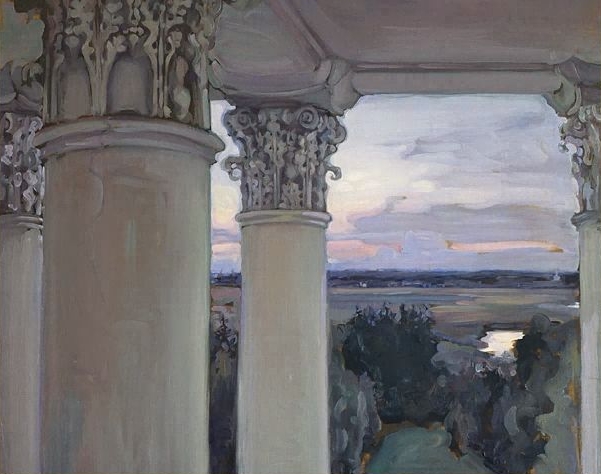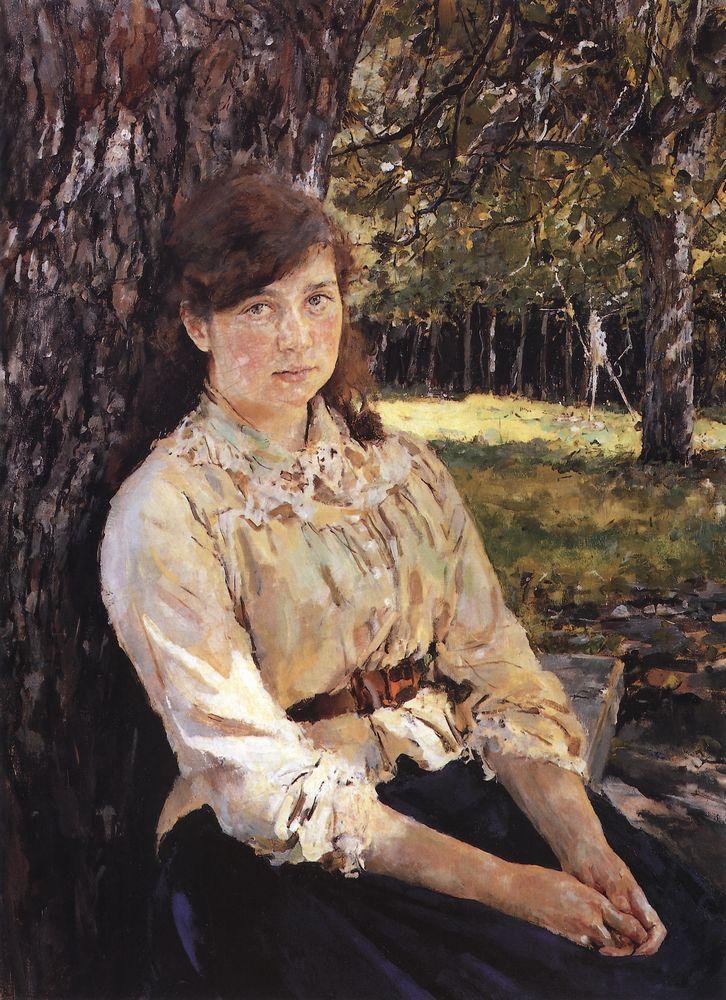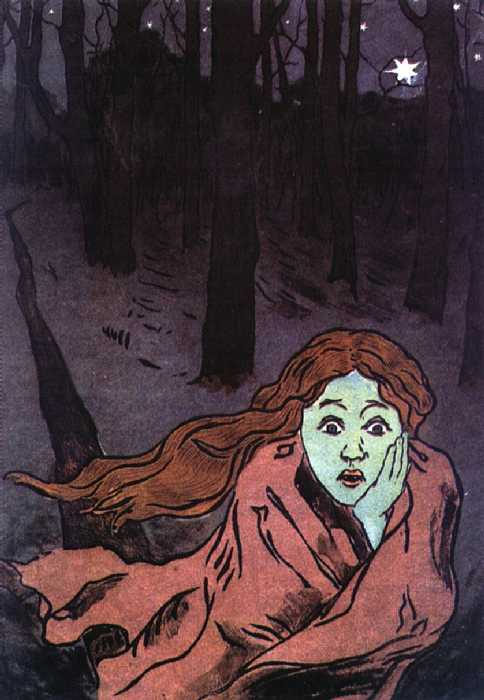|
Maria Yakunchikova
Maria Vasilievna Yakunchikova-Weber (russian: Мария Васильевна Якунчикова-Вебер) (January 19, 1870 – December 27, 1902) was a Russian painter and graphic artist. Early life and education Yakunchikova was born in Wiesbaden, Germany in a prosperous industrialist family, and grew up in Moscow. Her family was very musical: her father, Vasily Ivanovich, was an expert at the violin, while her mother, Zinaida, played the pianoforte. Indeed, her father sponsored the construction of the Moscow Conservatory. Yakunchikova's own interests, however, turned towards the fine arts. In 1882, following her sister Natalya's marriage to the landscape artist Vasily Polenov, his sister - Elena Polenova - also a fine artist, became a close friend. The Polenov residence was to become an important training centre for budding artists, and Yakunchikova joined as well, taking evening lessons with Elena between 1886 and 1889. Here she met artists such as Isaac Levitan, Val ... [...More Info...] [...Related Items...] OR: [Wikipedia] [Google] [Baidu] |
Wiesbaden
Wiesbaden () is a city in central western Germany and the capital of the state of Hesse. , it had 290,955 inhabitants, plus approximately 21,000 United States citizens (mostly associated with the United States Army). The Wiesbaden urban area is home to approximately 560,000 people. Wiesbaden is the second-largest city in Hesse after Frankfurt, Frankfurt am Main. The city, together with nearby Frankfurt am Main, Darmstadt, and Mainz, is part of the Frankfurt Rhine Main Region, a metropolitan area with a combined population of about 5.8 million people. Wiesbaden is one of the oldest spa towns in Europe. Its name translates to "meadow baths", a reference to its famed hot springs. It is also internationally famous for its architecture and climate—it is also called the "Nice of the North" in reference to the city in France. At one time, Wiesbaden had 26 hot springs. , fourteen of the springs are still flowing. In 1970, the town hosted the tenth ''Hessentag Landesfest'' (En ... [...More Info...] [...Related Items...] OR: [Wikipedia] [Google] [Baidu] |
Valentin Serov
Valentin Alexandrovich Serov (russian: Валенти́н Алекса́ндрович Серо́в; 19 January 1865 – 5 December 1911) was a Russian painter and one of the premier portrait artists of his era. Life and work Youth and education Serov was born in Saint Petersburg, son of the Russian composer and music critic Alexander Serov and his wife and former student Valentina Serova, also a composer in her own right. Raised in a highly artistic milieu he was encouraged to pursue his talents by his parents and in his childhood he studied in Paris and Moscow under Ilya Repin and in the St. Petersburg Academy of Arts (1880–1885) under Pavel Chistyakov. Serov's early creativity was sparked by the realistic art of Repin and strict pedagogical system of Chistyakov. Further influences on Serov were the old master paintings he viewed in the museums of Russia and Western Europe, friendships with Mikhail Vrubel and (later) Konstantin Korovin, and the creative atmosphere ... [...More Info...] [...Related Items...] OR: [Wikipedia] [Google] [Baidu] |
Italy
Italy ( it, Italia ), officially the Italian Republic, ) or the Republic of Italy, is a country in Southern Europe. It is located in the middle of the Mediterranean Sea, and its territory largely coincides with the homonymous geographical region. Italy is also considered part of Western Europe, and shares land borders with France, Switzerland, Austria, Slovenia and the enclaved microstates of Vatican City and San Marino. It has a territorial exclave in Switzerland, Campione. Italy covers an area of , with a population of over 60 million. It is the third-most populous member state of the European Union, the sixth-most populous country in Europe, and the tenth-largest country in the continent by land area. Italy's capital and largest city is Rome. Italy was the native place of many civilizations such as the Italic peoples and the Etruscans, while due to its central geographic location in Southern Europe and the Mediterranean, the country has also historically been home ... [...More Info...] [...Related Items...] OR: [Wikipedia] [Google] [Baidu] |
Austria
Austria, , bar, Östareich officially the Republic of Austria, is a country in the southern part of Central Europe, lying in the Eastern Alps. It is a federation of nine states, one of which is the capital, Vienna, the most populous city and state. A landlocked country, Austria is bordered by Germany to the northwest, the Czech Republic to the north, Slovakia to the northeast, Hungary to the east, Slovenia and Italy to the south, and Switzerland and Liechtenstein to the west. The country occupies an area of and has a population of 9 million. Austria emerged from the remnants of the Eastern and Hungarian March at the end of the first millennium. Originally a margraviate of Bavaria, it developed into a duchy of the Holy Roman Empire in 1156 and was later made an archduchy in 1453. In the 16th century, Vienna began serving as the empire's administrative capital and Austria thus became the heartland of the Habsburg monarchy. After the dissolution of the H ... [...More Info...] [...Related Items...] OR: [Wikipedia] [Google] [Baidu] |
En Plein Air
''En plein air'' (; French for 'outdoors'), or ''plein air'' painting, is the act of painting outdoors. This method contrasts with studio painting or academic rules that might create a predetermined look. The theory of 'En plein air' painting is credited to Pierre-Henri de Valenciennes (1750–1819), first expounded in a treatise entitled ''Reflections and Advice to a Student on Painting, Particularly on Landscape'' (1800), where he developed the concept of landscape portraiture by which the artist paints directly onto canvas ''in situ'' within the landscape. It enabled the artist to better capture the changing details of weather and light. The invention of portable canvases and easels allowed the practice to develop, particularly in France, and in the early 1830s the Barbizon school of painting in natural light was highly influential. Amongst the most prominent features of this school were its tonal qualities, colour, loose brushwork, and softness of form. These were varian ... [...More Info...] [...Related Items...] OR: [Wikipedia] [Google] [Baidu] |
Folk Art
Folk art covers all forms of visual art made in the context of folk culture. Definitions vary, but generally the objects have practical utility of some kind, rather than being exclusively decorative art, decorative. The makers of folk art are typically trained within a popular tradition, rather than in the fine art tradition of the culture. There is often overlap, or contested ground with naive art, 'naive art'. "Folk art" is not used in regard to traditional societies where ethnographic art continue to be made. The types of objects covered by the term "folk art" vary. The art form is categorised as "divergent... of cultural production ... comprehended by its usage in Europe, where the term originated, and in the United States, where it developed for the most part along very different lines." For a European perspective, Edward Lucie-Smith described it as "Unsophisticated art, both fine and applied, which is supposedly rooted in the collective awareness of simple people. ... [...More Info...] [...Related Items...] OR: [Wikipedia] [Google] [Baidu] |
Pokerwork
Pyrography or pyrogravure is the free handed art of decorating wood or other materials with burn marks resulting from the controlled application of a heated object such as a poker. It is also known as pokerwork or wood burning. The term means "writing with fire", from the Greek (fire) and (writing). It can be practiced using specialized modern pyrography tools, or using a metal implement heated in a fire, or even sunlight concentrated with a magnifying lens. "Pyrography dates from the 17th century and reached its highest standard in the 19th century. In its crude form it is pokerwork." Pyrography is also popular among gourd crafters and artists, where designs are burned onto the exterior of a dried hard-shell gourd. History Pyrographer Robert Boyer hypothesizes that the art form dates back to prehistory when early humans created designs using the charred remains of their fires. It was known in China from the time of the Han dynasty, where it was known as "Fire Needle Em ... [...More Info...] [...Related Items...] OR: [Wikipedia] [Google] [Baidu] |
Handicraft
A handicraft, sometimes more precisely expressed as artisanal handicraft or handmade, is any of a wide variety of types of work where useful and decorative objects are made completely by one’s hand or by using only simple, non-automated related tools like scissors, carving implements, or hooks. It is a traditional main sector of craft making and applies to a wide range of creative and design activities that are related to making things with one's hands and skill, including work with textiles, moldable and rigid materials, paper, plant fibers,clay etc. One of the oldest handicraft is Dhokra; this is a sort of metal casting that has been used in India for over 4,000 years and is still used. In Iranian Baluchistan, women still make red ware hand-made pottery with dotted ornaments, much similar to the 5000-year-old pottery tradition of Kalpurgan, an archaeological site near the village. Usually, the term is applied to traditional techniques of creating items (whether for per ... [...More Info...] [...Related Items...] OR: [Wikipedia] [Google] [Baidu] |
Abramtsevo Colony
Abramtsevo (russian: Абра́мцево) is a former country estate and now museum-reserve located north of Moscow, in the proximity of Khotkovo, that became a centre for the Slavophile movement and an artists' colony in the 19th century. The estate is located in the village of Abramtsevo, in Sergiyevo-Posadsky District of Moscow Oblast. The Abramtsevo Museum-reserve site is an object of cultural heritage in Russia. History Originally owned by the author Sergei Aksakov, other writers and artists — such as Nikolai Gogol — at first came there as his guests. Under Aksakov, visitors to the estate discussed ways of ridding Russian art of Western influences to revive a purely national style. In 1870, eleven years after Aksakov's death, it was purchased by Savva Mamontov, a wealthy industrialist and patron of the arts. Under Mamontov, Russian themes and folk art flourished there. During the 1870s and 1880s, Abramtsevo hosted a colony of artists who sought to recapture the quali ... [...More Info...] [...Related Items...] OR: [Wikipedia] [Google] [Baidu] |
Yakunchikova Fear
Maria Vasilievna Yakunchikova-Weber (russian: Мария Васильевна Якунчикова-Вебер) (January 19, 1870 – December 27, 1902) was a Russian painter and graphic artist. Early life and education Yakunchikova was born in Wiesbaden, Germany in a prosperous industrialist family, and grew up in Moscow. Her family was very musical: her father, Vasily Ivanovich, was an expert at the violin, while her mother, Zinaida, played the pianoforte. Indeed, her father sponsored the construction of the Moscow Conservatory. Yakunchikova's own interests, however, turned towards the fine arts. In 1882, following her sister Natalya's marriage to the landscape artist Vasily Polenov, his sister - Elena Polenova - also a fine artist, became a close friend. The Polenov residence was to become an important training centre for budding artists, and Yakunchikova joined as well, taking evening lessons with Elena between 1886 and 1889. Here she met artists such as Isaac Levitan, Val ... [...More Info...] [...Related Items...] OR: [Wikipedia] [Google] [Baidu] |
Yakunchikova Coloumns
Maria Vasilievna Yakunchikova-Weber (russian: Мария Васильевна Якунчикова-Вебер) (January 19, 1870 – December 27, 1902) was a Russian painter and graphic artist. Early life and education Yakunchikova was born in Wiesbaden, Germany in a prosperous industrialist family, and grew up in Moscow. Her family was very musical: her father, Vasily Ivanovich, was an expert at the violin, while her mother, Zinaida, played the pianoforte. Indeed, her father sponsored the construction of the Moscow Conservatory. Yakunchikova's own interests, however, turned towards the fine arts. In 1882, following her sister Natalya's marriage to the landscape artist Vasily Polenov, his sister - Elena Polenova - also a fine artist, became a close friend. The Polenov residence was to become an important training centre for budding artists, and Yakunchikova joined as well, taking evening lessons with Elena between 1886 and 1889. Here she met artists such as Isaac Levitan, Val ... [...More Info...] [...Related Items...] OR: [Wikipedia] [Google] [Baidu] |
University Of Paris
, image_name = Coat of arms of the University of Paris.svg , image_size = 150px , caption = Coat of Arms , latin_name = Universitas magistrorum et scholarium Parisiensis , motto = ''Hic et ubique terrarum'' (Latin) , mottoeng = Here and anywhere on Earth , established = Founded: c. 1150Suppressed: 1793Faculties reestablished: 1806University reestablished: 1896Divided: 1970 , type = Corporative then public university , city = Paris , country = France , campus = Urban The University of Paris (french: link=no, Université de Paris), metonymically known as the Sorbonne (), was the leading university in Paris, France, active from 1150 to 1970, with the exception between 1793 and 1806 under the French Revolution. Emerging around 1150 as a corporation associated with the cathedral school of Notre Dame de Paris, it was considered the second-oldest university in Europe. Haskins, C. H.: ''The Rise of Universities'', Henry Holt and Company, 1923, p. 292. Officially chartered i ... [...More Info...] [...Related Items...] OR: [Wikipedia] [Google] [Baidu] |




.jpg)




